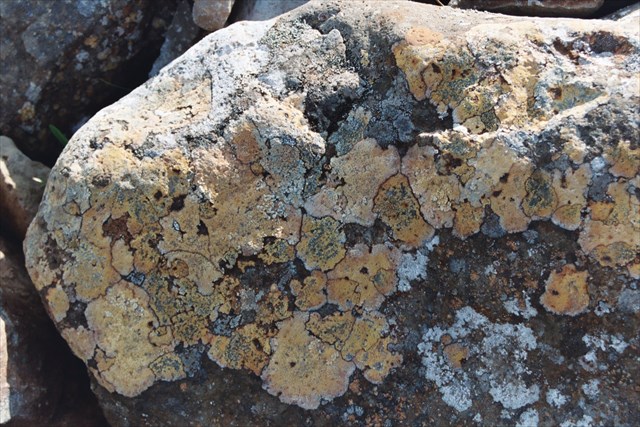Physical Weathering
Physical weathering, sometimes called mechanical weathering, includes all the processes which break rocks apart without changing their chemical composition. Following are examples of physical weathering processes.
Rock Abrasion
Rock abrasion occurs when rocks collide with one another or rub against one another. Collisions, if they are strong enough, can cause pieces of rock to break into two or more pieces, or cause small chips to be broken off a large piece. When two pieces of rock are rubbed together, the mineral grains in the rocks can be broken away from the rock surface. Rock abrasion occurs commonly in landslides where pieces of rock slide past one another as the mass moves downhill. It also occurs at the base of a glacier where pieces of rock that are frozen into the ice are dragged along beneath the glacier. In fast-moving streams and rivers, pieces of rock that are being moved by the flow rub against one another and against other pieces resting on the river bed.
Ice or frost wedging
Ice wedging refers to the repeated freezing and melting of water within small cracks in rocks near the surface. The water in the cracks freezes as the temperature drops below freezing. As the water freezes, it expands. This expansion exerts tremendous pressure on the surrounding rock and acts like a wedge, making cracks wider. After repeated freezing and thawing of water, the rock breaks apart. This should be quite evident at this site.
This process can be seen at home by placing a full water bottle into a freezer. When the water freezes it will expand and may burst or pop the cap off if left loose. A can of pop will usually burst.

Root wedging
Plant roots can grow in cracks and small crevices. As the plant grows, the root becomes larger and can exert enough pressure to split the rock. The pressure of a confined growing root can be substantial. These pressures make cracks in the rocks larger, and, as roots grow, they can break rocks apart. The roots can also produce enzymes that can attack certain rock minerals. This process is called chemical weathering.

Chemical Weathering Processes
Chemical weathering is the decomposition of rocks due to chemical reactions occurring between the minerals in rocks and the environment. Following are examples of the chemical weathering processes.
Water
Water, and many chemical compounds found in water, is the main agent of chemical weathering. Feldspar, one of the most abundant rock-forming minerals, chemically reacts with water and water-soluble compounds to form clay.
Acids
Water contains many weak acids, such as carbonic acid. This weak, but abundant, acid is formed when carbon dioxide gas from the atmosphere mixes with rainwater. Sulfur dioxide and nitrogen gases create other types of acids that act as chemical weathering agents. Some sources of sulfur dioxide are power plants that burn coal; as well as volcanoes and coastal marshes. Sulfur gases react with oxygen and rainwater to form sulfuric acid. Although relatively weak, this acid’s abundance and long term effects produce noticeable damage to vegetation, fabrics, paints and rocks. Acid rain can dull the painted surface of vehicles and over a greater amount of time can help break down rock.
Oxidation
Oxidation is another kind of chemical weathering that occurs when oxygen combines with another substance and creates compounds called oxides. Rust, for example, is iron oxide. When rocks, particularly those with iron in them, are exposed to air and water, the iron undergoes oxidation, which can weaken the rocks and make them crumble.
Biological Weathering
Biological weathering would include the effect of animals and plants on the landscape. This is more than roots digging in and wedging rocks. Biological weathering is the actual molecular breakdown of minerals. There are things called lichens (combinations of fungi and algae) which live on rocks. Lichens slowly eat away at the surface of rocks. The amount of biological activity that breaks down minerals depends on how much life is in that area. You might find more activities like lichens near oceans where the air is humid and cooler.

To log this Earthcache send me the answers to the following questions;
1. How big is the boulder you find at GZ? Height? Width? Length?
2. How wide is the crack, at the top, between the two major pieces of the boulder?
3. Roughly estimate the number of broken fragments inside the crack created by the ice wedging process.
4. There are two other physical forces working on splitting and breaking up this boulder, that are mentioned above, what are they? One is in the crack and one is on one face of the boulder. Which face, north or south, is this object?
5. Water can act to weather a rock, as mentioned above, how deep is the water below the rock? Is there any?
Further reading
http://www.tclauset.org/20_ESbk/ch11.pdf
http://jessedavenport.com/wordpress/tag/weathering/
http://inside.mines.edu/~cshorey/NewFiles/Lecture%206-Weathering%20and%20soil.pdf
http://www.geography4kids.com/files/land_weathering.html
http://www.eschooltoday.com/rocks/what-is-physical-weathering-of-rocks.html
http://www.moorlandschool.co.uk/earth/rockcycle.htm